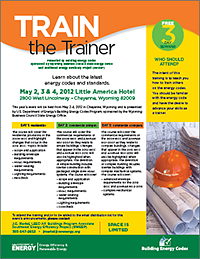Step 7. Outline Who is Responsible for Satisfying What is Adopted
Description
A critical step in the energy code adoption process is outlining who is responsible for satisfying what is adopted. A well-written energy code will include the role that each entity has in ensuring the adopted code is carried out. This includes specific instructions for the design and build communities, including architects and contractors, as well as those involved in validating that a home or building complies with the adopted code. The energy code should specify who will determine compliance, the time at which compliance is determined, and the appropriate method for determining compliance.
While this is more relevant to the compliance and enforcement communities, including these elements and having a clear plan for how the energy code will be carried out will encourage buy-in from stakeholders and engage all critical industry professionals in the adoption process. For more detailed information on specific compliance and enforcement issues, see the compliance and enforcement toolkits developed by BECP (Resources 1 and 2 of this step).
Recommendations
Include specific instructions on who will determine compliance. Code officials, builders, designers, lenders, insurance underwriters, realtors, and utilities are all possible candidates for assessing, verifying, and documenting compliance with the code. For more information on how these entities can be used to verify code compliance, see Resource 3 of this step, "Compliance Verification Paths for Residential and Commercial Energy Codes."
Specify when compliance will be determined. There are several possible touch points during the life of a building that are relevant to compliance with an adopted code. The earliest point is when components that will be used in a building are designed, constructed, tested, certified, labeled, and shipped for sale; the last point occurs long after the building is occupied.
Between these two points, compliance could be assessed at initial design, during preparation of the final design and specifications, during construction, at the completion of construction concurrent with pre-occupancy commissioning, and at any time after initial occupancy.
Once a certificate of occupancy has been issued and a project becomes an existing building, any alterations, additions, repairs, renovations, remodeling, or changes in occupancy or use of the building can necessitate additional energy code compliance activities. During the life of a commercial building, these changes may occur many times. As such, an assessment of compliance with the energy code for all or portions of the building may occur many times as well.
Outline the methods that will be used to determine compliance with the adopted code. Depending on the individual and collective provisions of an energy code and the format used to present the provisions, compliance verification methods may include: testing, simulation, surveillance, inspection, auditing, certification, registration, and accreditation. Detailed discussion on these methods can be found in Resource 3 of this step.
Invest in a code compliance assessment. The building code council (or similar group) should engage in a study of compliance with the state's energy code provisions. No compliance goal can be reasonably met without developing appropriate techniques and metrics for compliance assessment.
Promote code compliance locally. The State Energy Office (SEO) has regional representatives that assist with regional projects and objectives.

In the spirit of "Train the Trainer," the building code council and SEO could develop a pool of local experts and resources to assist with code education and compliance.
The notion of an experienced "energy circuit rider" can also assist builders, building inspectors and others in the building industry with code education. The SEO could also engage the state's community colleges in this regional support task.
